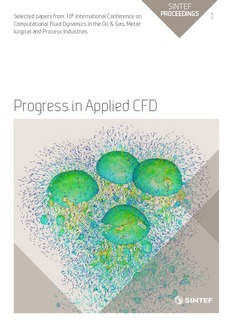| dc.contributor.author | Witt, Peter J. | |
| dc.contributor.author | Feng, Yuqing | |
| dc.contributor.author | Snook, Graeme A. | |
| dc.contributor.author | Eick, Ingo | |
| dc.contributor.author | Cooksey, Mark | |
| dc.date.accessioned | 2017-11-08T06:45:05Z | |
| dc.date.available | 2017-11-08T06:45:05Z | |
| dc.date.issued | 2015 | |
| dc.identifier.isbn | 978-82-536-1433-5 | |
| dc.identifier.isbn | 978-82-536-1432-8 | |
| dc.identifier.issn | 2387-4295 | |
| dc.identifier.uri | http://hdl.handle.net/11250/2464760 | |
| dc.description.abstract | The industrial process for producing primary aluminium metal is the reduction of powdered alumina in a Hall-Héroult reduction cell. These cells operate at temperatures above 940 °C with a highly corrosive electrolyte making physical measurement of the process difficult or nearly impossible. Computational models of the electro-magnetic fields and heat transfer are widely used in industry to design cells. Only recently (Feng et al., 2010b, Witt et al., 2012) have detailed computational models of the molten liquid-gas bath become available. Alumina distribution within the cells is important for cell efficiency and preventing anode effects. Using the bath flow information and an assumption of uniform reduction, a single scalar transport equation has been used to track the time variation of alumina within cells (Feng et al., 2011). In this work the previous single species model is extended to include six chemical species and four chemical reactions. The reaction pathway developed for the model is that solid alumina particles are fed to the bath surface, where they mix and submerge into the liquid bath, and then undergo dissolution from solid particles to the liquid species Na2Al2O2F4. Within the bath Na2Al2O2F4 converts to Na2Al2OF6, which is involved in an oxidation reaction with carbon to produce carbon dioxide and AlF3 at the anode surface. At the metal pad a cathodic reaction occurs with AlF3 converting to aluminium metal. Species solubility rates are based on the work of Solheim et al. (1995). A CFD model of a single anode in a bubbly cryolite bath was built based on a corner anode from an industrial cell. Steady state bath flows were calculated and used to transport the six chemical species in the new bath chemistry model. Results were obtained for 20,000 seconds of real time for species distributions in the anode to cathode distance (ACD), change in mass of species in the bath with time, rates for the four reactions at locations in the bath and change in the species mass fraction with time at various locations during a feeding cycle. | |
| dc.description.sponsorship | ACKNOWLEDGMENTS. The present work was supported by the project “Gas and Alumina Distribution and Transport” (GADT), financed by the Research Council of Norway and Hydro Primary Metal Technology. Permission to publish the results is gratefully acknowledged. The authors wish to acknowledge the valuable discussions and advice provided by Asbjorn Solheim on the electro-chemical reactions, rates and processes in aluminium reductions cells. | |
| dc.language.iso | eng | |
| dc.publisher | SINTEF Academic Press | |
| dc.relation.ispartof | Selected papers from 10th International Conference on Computational Fluid Dynamics in the Oil & Gas, Metallurgical and Process Industries | |
| dc.relation.ispartofseries | SINTEF Proceedings;1 | |
| dc.subject | CFD | |
| dc.subject | Process metallurgy | |
| dc.subject | Alumina reduction chemistry | |
| dc.subject | Hall-Héroult aluminium cell | |
| dc.subject | Multiphase chemistry | |
| dc.title | A six chemical species CFD model of alumina reduction in a Hall-Héroult cell | |
| dc.type | Chapter | |
| dc.description.version | publishedVersion | |
| dc.rights.holder | © 2015 SINTEF Academic Press | |
| dc.subject.nsi | VDP::Technology: 500 | |
